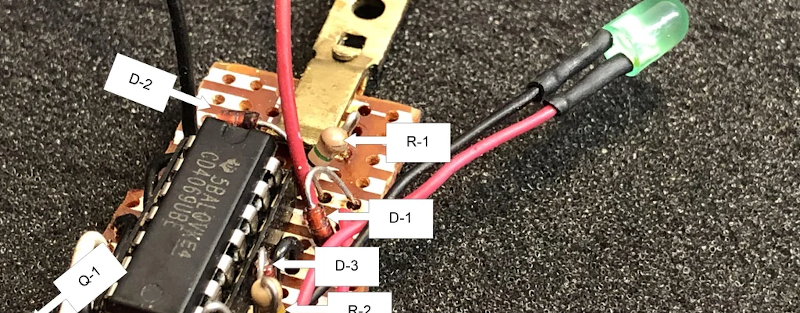Non-contact voltage probes have been around a while and some test equipment now has them built-in. This is one of those things that you probably don’t think about much, but surely it isn’t that hard to detect AC voltage. Turns out there are a lot of circuits floating around that can do it and [nsievers51] tried a bunch. Many didn’t work very well, but the best used a 4069 CMOS hex inverter. A dollar store flashlight provided power, a case, and an LED and the result was a good-looking and effective probe.
The circuit came from the Electronics Library website and is fairly complex for this sort of device. The CMOS inverters have a high input impedance so they pick up the weak signal. Instead of directly driving an LED, two inverters form a ring oscillator that generate pulses around 1 kHz. At that frequency, the LED appears to be on, but battery consumption is less severe. A single 2N2222-style transistor drives the LED.
We’ve seen a number of variations on this tool in the past. Many of them only use transistors.















Most non contact testers detect an electric field, not AC specifically
Meh, quite an simplistic circuit (but useful none-the-less).
One of my DMM’s has a non-contact-probe with 3 different detection levels. This is a useful addon because it gives you more confidence into what you’re measuring as you see you get a stronger signal when the probe is nearing a high AC voltage.
Adding an LM3914 (if that still exists) could easily remedy that. It could also be done with some PWM thingie.
Also:
Here in the EU both wires of 230Vac are considered “live” and treated the same. Sometimes it’s handy to know which of the wires is neutral, and which is the live wire. One way to sense this is by holding one hand over the NVC sensor of your DMM, and then probing the wall socket with one wire of your DMM.
With addition of LM3914, you get “Ghostbusters” detector ;-)
@paulvdh said: :Meh, quite an simplistic circuit (but useful none-the-less).
One of my DMM’s has a non-contact-probe with 3 different detection levels. This is a useful addon because it gives you more confidence into what you’re measuring as you see you get a stronger signal when the probe is nearing a high AC voltage. Adding an LM3914 (if that still exists) could easily remedy that.”
The LM3914 is still active at TI [1], but only in a 20PLCC SMT package. The LM3914N in a 19PDIP package is deprecated at TI, but they are still easy to find online for around a buck each (maybe they’re Chinese clones).[2] Digi-Key has the 20PLCC LM3914V in stock (qty.-520 immediate) for qty.-1-9 @ $5.15 USD each (yikes!)[3]
* References:
1. LM3914 Dot/Bar Display Driver
https://www.ti.com/product/LM3914
2. LM3914N-1 LM3914 Dot Bar Graph Display Driver DIP-18 Pack of 10 4.6 out of 5 stars 12 ratings $9.90
– Part number LM3914N-1 DIP-18
– Drives LEDs, LCDs or vacuum fluorescents Bar or dot display mode
– Selectable for Bar or dot display mode
– Expandable to displays of 100 steps
– Pack of 10
https://www.amazon.com/LM3914N-1-LM3914-Display-Driver-DIP-18/dp/B085HKX6V9
3. TI LM3914V/NOPB
https://www.digikey.com/en/products/detail/texas-instruments/LM3914V-NOPB/212685
Safety schmafety.
I have a store bought non-contact probe and it has an important safety feature– when I press the button to start probing, it gives a beep and a flash to indicate that it is working. Without this arguably essential feature, you would/should make sure that the probe is functional before trusting that a circuit is unenergized.